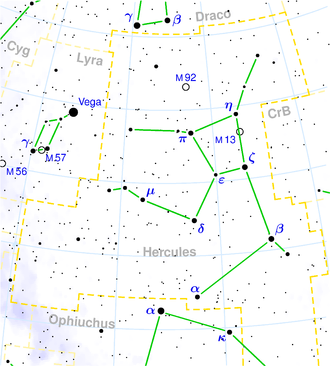NGC 6046
| Galaxy NGC 6028 / NGC 6046 |
|
|---|---|

|
|
| SDSS recording | |
| AladinLite | |
| Constellation | Hercules |
|
Position equinox : J2000.0 , epoch : J2000.0 |
|
| Right ascension | 16 h 01 m 29.0 s |
| declination | + 19 ° 21 ′ 35 ″ |
| Appearance | |
| Morphological type | (R) SA0 +: / LINER |
| Brightness (visual) | 13.5 likes |
| Brightness (B-band) | 14.4 mag |
| Angular expansion | 1.3 ′ × 1.1 ′ |
| Position angle | 30 ° |
| Surface brightness | 13.8 mag / arcmin² |
| Physical data | |
| Redshift | 0.014927 ± 0.000030 |
| Radial velocity | (4475 ± 9) km / s |
|
Stroke distance v rad / H 0 |
(205 ± 14) · 10 6 ly (62.7 ± 4.4) Mpc |
| history | |
| discovery | Wilhelm Herschel |
| Discovery date | March 14, 1784 |
| Catalog names | |
| NGC 6046 • 6028 • UGC 10135 • PGC 56716 • CGCG 108-063 • MCG + 03-41-43 • 2MASX J16012897 + 1921356 • GC 4157 • H III 33 • LDCE 1163 NED007 | |
NGC 6028 = NGC 6046 is a lenticular ring galaxy with an active galaxy core of the Hubble type S0 / a in the constellation Hercules in the northern sky . It is an estimated 205 million light years from the Milky Way and about 80,000 light years in diameter. In the same area of the sky is u. a. the galaxy IC 1156 .
The object was discovered on March 14, 1784 by Wilhelm Herschel with an 18.7-inch reflector telescope , which she labeled “eF, pL, partly veried with 240 power ... a neb. suspected by 157 and the suspicion strengthened by 240, but the latter power does not remove all doubt. It follows 3 pB stars making an arch (concave towards np. Or nnp. Direction by diagram) south of which arch there is a still brighter star ”.
Due to an incorrect position specification in Herschel's notes, the observation of Guillaume Bigourdan on May 4, 1886 under NGC 6028 led to the second entry in the catalog.
